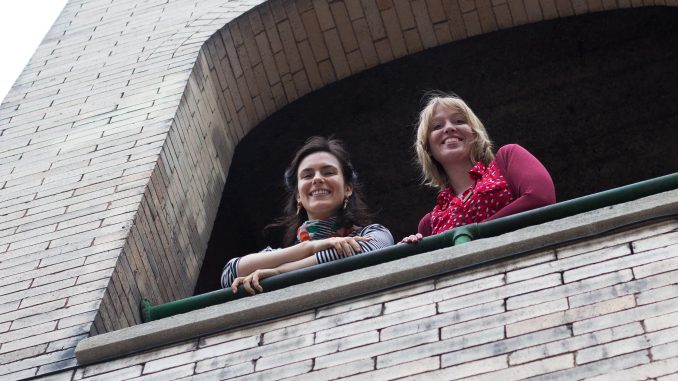
When Abby King was moving out of her sixth-floor studio at 319 N. 11 St., she wanted to take a piece of the building with her.
In a way, she did—King took large-scale prints of the floor in her studio, which are now immortalized in her exhibit, “Ingrained.”
“She sort of wanted to take some sort of token of the building with her, so she started printing the floor,” said Marie Manski, King’s partner on the installation.
“This is where I came when I was a student,” King added. “So this is kind of the center of where I began to understand what the contemporary art scene was here in Philly. It was great to dig deeper into that idea.”
The installation, located in the same building as King’s studio, is made up of 300 yards of interfacing material. The material is suspended from the ceiling, showcasing the prints of her studio floor, created in a mixture of black acrylic paint and ink.
Manski and King, both 2013 MFA graduates from The Pennsylvania Academy of Fine Arts, painted the floor in six-foot segments to take its imprint.
“I think this project is a lot about reflection,” Manski said. “[Like] reflecting on the history of this building with the Philadelphia arts community. I see the print of the floors as sort of like meditating on what we often times ignore. We often ignore what we walk on, so [we’re] bringing it to eye level, making it a subject.”
Manski said thinking about how many people walked on the same floors before her is an essential part to this installation. She and King first proposed the idea for “Ingrained” to Automat Collective, a fledgling curatorial organization, when it had an open call for a two-week exhibition.
“When they first proposed [‘Ingrained’] to us, we liked it, but we wanted to give them time to develop it,” said Jillian Schley, one of the founders of Automat. “The way they proposed it to us, it sounded like an intense installation, so we didn’t want to rush them.”
The installation is meant to pay tribute to the extensive history of the building in which it is shown. Manski and King conducted seven planned interviews with people who had intimate ties with the building, and also spoke to more than 48 people about the building.
“There’s seven different vignettes inside,” Manski said. “Each vignette is inspired by stories that we have collected from people that have had some sort of interaction with this building whether it be having a studio here or just passing by.”
One vignette was inspired by the run-down nature of the building—complete with a collection of trash at one corner of the maze-like exhibition. All the trash was found either in the building or within a three-block radius, King said—gathered at 2 a.m., in the rain.
Manski said labyrinths “represent a journey that is designed to be a guide,” as opposed to a maze, which is “something that you get lost in.”
“A labyrinth is meant for reflection,” she added—something she and King know intimately.
“Growing up, my mom would take me on weird pilgrimages to different labyrinths to walk through as a kid,” King said. “I’m from Kentucky, so there’s a lot of weird ones in these hippie towns. We would drive five hours to walk through these labyrinths. That was sort of her spiritual practice.”
In addition to King’s experience with labyrinths, Manski has been incorporating them into her work since her time at PAFA.
“I’ve just found that the concept of labyrinths overlap with what I’m interested in doing in my art,” Manski said. “I think labyrinths represent a larger community, and I think that they’re interactive.”
Both artists are drawn to the idea of art as an experience, making the idea of a labyrinth key to “Ingrained.” Each viewer is meant to have their own separate interpretation and experience when walking through the installation.
“A labyrinth is not just something that you look at,” Manski added. “It demands you to have an experience.”
Erin Blewett can be reached at erin.clare.blewett@temple.edu.


Be the first to comment